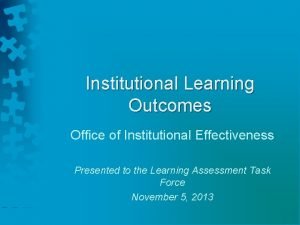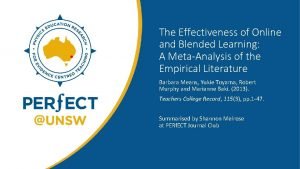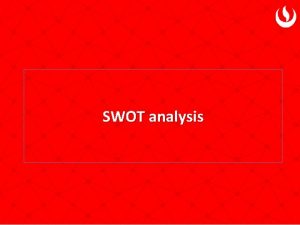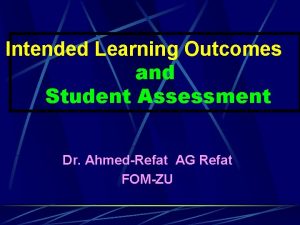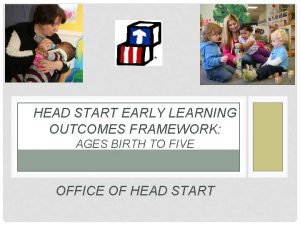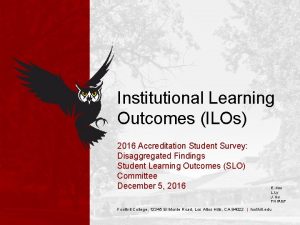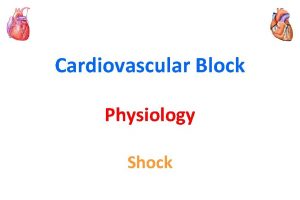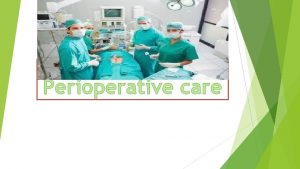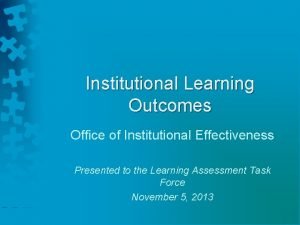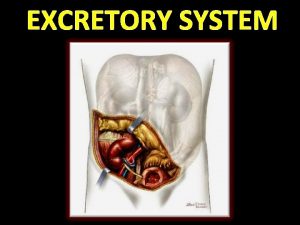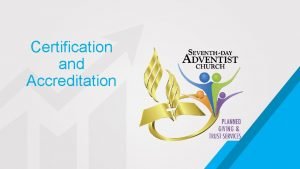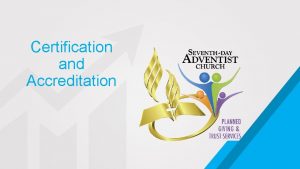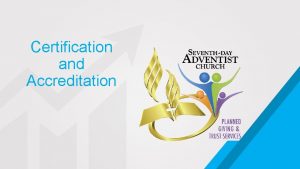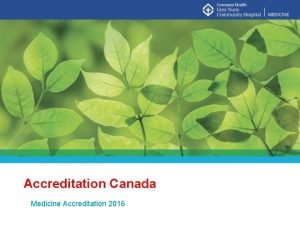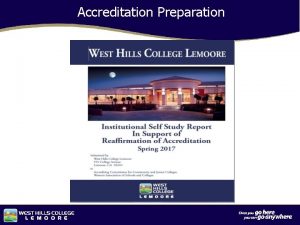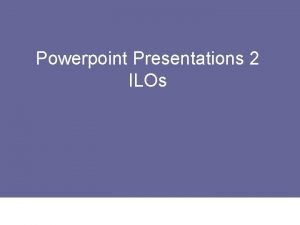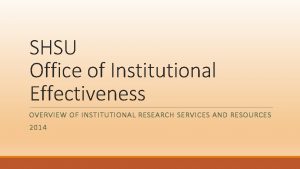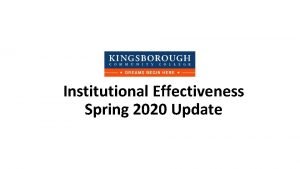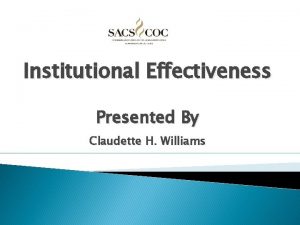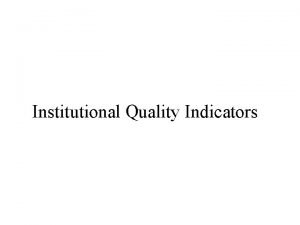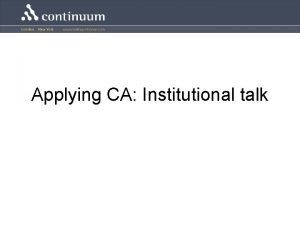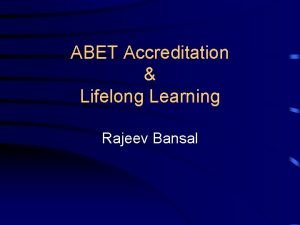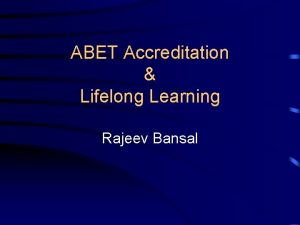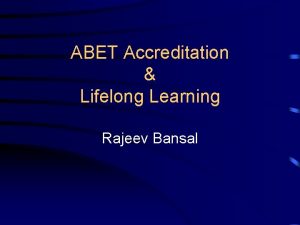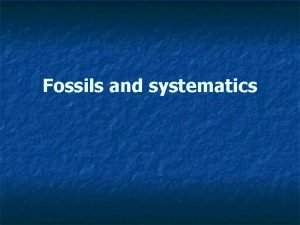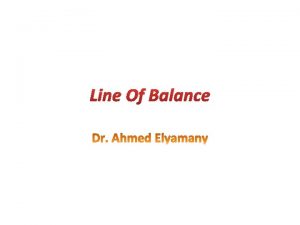Institutional Effectiveness and Accreditation Intended Learning Outcomes ILOs

























- Slides: 25

Institutional Effectiveness and Accreditation Intended Learning Outcomes (ILOs) Prepared by: Prof. Maha Aboul Ela Head of Pharmaceutical Sciences Department Faculty of Pharmacy Beirut Arab University

Contents • • • Types of Accreditation Overview of the Accreditation standards Preparation for Accreditation Program ILOs Assessment What is specifically required from the campus, college, committee and faculty members?

Types of Accreditation 3

TYPES OF ACCREDITING AGENCIES • National Agencies: Accredit specific types of institutions wherever they are located. • Regional Agencies: Accredit institutions of higher education in specific regions. • Specialized or Professional Agencies: Accredit programs within institutions.

Specialized and Professional Accrediting Agencies • • AACSB ABET ACPE NCATE NASM FIDER AVMA (Business) (Engineering) (Pharmacy) (Teacher Education) (Music) (Interior Design) (Veterinary Schools)

SIX REGIONAL ACCREDITING ASSOCIATIONS

Accreditation Standards 7

Evolution of the Standards for Academic Accreditation and Licensure 2001 2003 2005 1. Principles of Licensure and Accreditation 2. Institutional Purpose and Effectiveness 2. Purpose, Planning, and Effectiveness 3. Educational Program 4. Educational Support Services 5. Administrative Process 6. Institutional Effectiveness 3. Educational Program 4. Educational Support Services 5. Administrative Process 3. Educational Program 4. Educational and Student Support Services 5. Administrative Process 2007 2011 1. Mission and Institutional Effectiveness 1. Mission, Organization and Governance 2. Organization, Governance, and Leadership 2. Quality Assurance 3. Academic Program 3. The Educational Program 4. Faculty and Professional Staff 5. Students 6. Library and Other Information Resources 6. Learning Resources 7. Physical and Technology Resources 7. Physical Resources 8. Physical Resources 9. Public Disclosure and Integrity 10. Research and Scholarly Activities 11. Community Engagement 8


Industry Prospective Students Employers Competitors Alumni Partners Families Government An effective learning organization recognizes good ideas and expertise at all levels and encourages all members to develop their skills in an environment of trust, honesty and respect (Yorke, 2000) Accreditation Bodies (National and International) Board of Trustees University Administration Colleges Faculty Support & Administrative Units Students Staff

LO at the core of QA in the EHEA ? Implementation issues: • Formulation of LOs: too generic or too detailed/numerous? • significant language issues • Setting adequate LOs for particular courses • Tracing LOs with particular course items and learning methods

• Measuring LOs : student assessment in LOs remains an issue transfer credits for mobile students. • LOs in HEIs’ submissions for accreditation - Sometimes more rhetoric than reality, superficial understanding of LOs. - Vagueness has generated confusion, undue claims, reticence. - Standardization of LOs instead of contents (through legislation, QA)?

Challenges for QA in the EHEA • QA/accreditation is not questioned in its existence: is here to stay. • But it should be re-oriented: - Towards a more open, dynamic vision of «quality» . - more strategic, oriented towards each HEI’s profile. - more emphasis on quality improvement and innovation (curricula/pedagogy).

Towards its real purposes: - more geared towards learners and learning. - easier access for users, legibility. - more focused on LOs, program performance, efficiency, regional impact more «professional » processes. - more inclusive of less traditional areas of HE/LLL.

INPUTS OUTPUTS • community needs • creativity • research • problem solving • problem identification • teaching / training • self learning • team work • leadership • user expectations • experience • culture • value • ethics O PM EL DE V AL EC TU IN T TE EN LL PM LO SYNTHESIS VE DE APPLICATION L NA O RS INTEGRATION PE EN T CHOICE ANALYSIS COMMUNICATION INFORMATION • autonomous learning • team work • critical approach DATA KNOWLEDGE ENABLING SKILLS • logic / analysis • interpersonal • technical / physical ELEMENTS OF HIGHER EDUCATION 15

OUTPUTS • creativity INPUTS CHOICE • community needs DE AL TU EC LL IN TE T EN PM O SYNTHESIS EL V DE APPLICATION L NA VE LO INTEGRATION O RS PM EN T • user expectations • experience • culture • value • ethics PE • research • problem solving • problem identification • teaching / training • self learning • team work • leadership ANALYSIS COMMUNICATION INFORMATION • autonomous learning • team work • critical approach KNOWLEDGE DATA ENABLING SKILLS • logic / analysis • interpersonal • technical / physical ELEMENTS OF HIGHER EDUCATION Adopted from different sources 16

Input – Process – Output – Outcome Model (IPOO)

Tools of Assessment/Evaluation Employers Survey Alumni Survey External Evaluation Reports Consultation Phase I Sem. 8 Student Exit Survey Sem. 7 Summative Test Sem. 6 Sem. 5 Sem. 4 Sem. 3 Sem. 2 Graduation Project Internship Semester 1 Formative Test ·Student Portfolio ·Course Evaluation by faculty ·Course Evaluation by Students ·Midterm exam ·Quizzes ·Project ·Report and Essay ·Presentation Analysis of outcome achievement (Institutional Research) Element Program Advisory Board Phase II Development of objectives, curriculum, teaching & learning tools & methods Chart for Program Outcomes Assessment (8 Semester Model)

Self Study or Annual Report • A document fulfilling general accreditation standards • Prepare supporting documents and evidence The University provides • Institutional effectiveness framework that consider program variations • Data and survey analysis • Faculty development • Guidance to the document preparation • Feedback to colleges and units

Samples of the required documents • Strategic plan • Annual reports • Institutional effectiveness report (including learning outcomes achievement) • Course file • Faculty portfolio • Internship or practical training manuals • Minutes of college council, department council, committees, etc.

Areas for Improvement and Actions Taken (Examples) What Triggered Change • Students feedback • Program educational outcomes • Market needs • Effectiveness of the Education program • Accreditation standards Action/Improvement Analyses & Follow up General Education Assessment / indicators • Achievement of program outcomes • Student satisfaction • Alumni and employers feedback • Academic accreditation Offer an updated university requirements program that cope with the student requirements and new trends and developments

Areas for Improvement and Actions Taken (Examples) What Triggered Change • Community needs • Market needs • Alumni feedback • New trends in education • Accreditation standards Analyses & Follow up Socio. Economic Changes Assessment / indicators • Providing the qualified HR • Employer satisfaction • Enrolled students • Scholarships Action/Improvement Offer programs in needed areas such as renewable and sustainable energy, Applied sociology, interdisciplinary programs, etc. to meet the needs

Senior Exit Survey Teamwork Ability to lead a team Problem solving Ability to critically examine ideas and issues Effective written communication Effective oral communication Effective use of IT Positive attitude toward community service Ability to adapt to other people’s traditions and values Ability to keep up-to-date with current issue Ability to take on professional responsibilities Ability to apply knowledge to real-life situations Ability to learn on his/her own

Senior Exit Survey The ability to use techniques, skills, and modern ……. . tools necessary for practice ……… The knowledge of contemporary issues The recognition of the need for, and an ability to engage in life-long learning. The board education necessary to realize the impact of ……. The ability to communicate effectively in two languages. The understanding of professional and ethical responsibility The ability to identify, formulate, and solve ……… problems…. The ability to function on multidisciplinary teams The ability to design a system, component, or process to meet desired …………. The ability to design and conduct experiments, as well as to analyze and interpret data related to speciality. The ability to apply knowledge of ……. . in different practice settings.

Thank You a h a Prof. M a l E l u Abo 25
 Institutional learning outcomes examples
Institutional learning outcomes examples The effectiveness of online and blended learning
The effectiveness of online and blended learning Planning goals and learning outcomes
Planning goals and learning outcomes Objectives of teaching direct and indirect speech
Objectives of teaching direct and indirect speech Purpose of output devices
Purpose of output devices Sound energy definition
Sound energy definition Learning objectives of profit and loss
Learning objectives of profit and loss Learning outcomes of work and energy
Learning outcomes of work and energy Indian and international number system
Indian and international number system Trade promotion machine learning
Trade promotion machine learning Expected outcome example
Expected outcome example Learning outcomes of water cycle
Learning outcomes of water cycle Objectives of teaching notice writing
Objectives of teaching notice writing What is the objective of swot analysis
What is the objective of swot analysis Objective of teaching rhymes
Objective of teaching rhymes Photolysis of water
Photolysis of water Objectives of photosynthesis
Objectives of photosynthesis Learning outcomes of ncbts
Learning outcomes of ncbts Objectives of linear equations in one variable
Objectives of linear equations in one variable Learning outcome generator
Learning outcome generator Purpose of learning outcomes
Purpose of learning outcomes Mri ib psychology
Mri ib psychology How to write an introduction for a reflective essay
How to write an introduction for a reflective essay Learning outcomes of holy week
Learning outcomes of holy week What is easter
What is easter Head start early learning outcomes framework
Head start early learning outcomes framework
